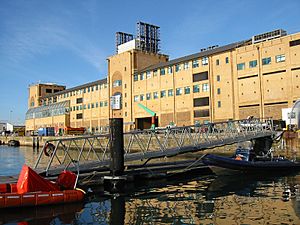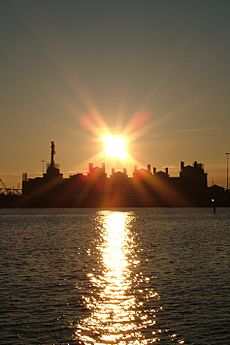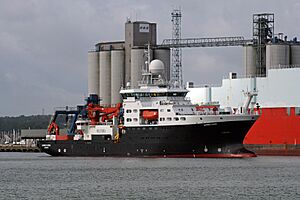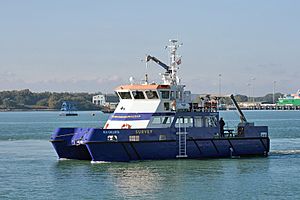National Oceanography Centre Southampton facts for kids
 |
|
|
Former name
|
Southampton Oceanography Centre (SOC) |
|---|---|
| Type | public research and teaching institution |
| Established | 1994 |
|
Academic staff
|
125 OES + 150 NOC |
| Undergraduates | 750 |
| Postgraduates | 45 |
| 205 | |
| Website | https://www.noc.ac.uk |
The National Oceanography Centre Southampton (NOCS) is a special place where scientists study the ocean and Earth. It's also a place for teaching and developing new technologies. NOCS started in 1995. It was a joint effort between the University of Southampton and the UK Natural Environment Research Council. You can find it right by the water in the port of Southampton. It has modern buildings built just for this purpose.
In 2010, the university and the Natural Environment Research Council parts of NOCS became separate. The part managed by the Natural Environment Research Council is now called the National Oceanography Centre (NOC). Even though they are separate, they still work closely together. They share research labs and work on many projects. The university part is called "Ocean and Earth Science, National Oceanography Centre Southampton" (OES). In 2019, this part was ranked 46th globally for Earth and Marine Sciences. In November 2019, NOC became fully independent. It now operates as a charity.
Contents
How NOCS Started
The story of NOCS goes back to after the Second World War. That's when the National Institute of Oceanography (NIO) was created. In the late 1980s and early 1990s, there was a plan to create a top center for marine and Earth science. This plan came from the Natural Environment Research Council and the University of Southampton.
A new research and teaching complex was built by the docks in the Port of Southampton. This new place became home to several groups. These included the National Institute of Oceanographic Science and the Research Vessel Service. The University of Southampton's Geology and Oceanography departments also moved there. NOCS officially opened in 1996. It was first called the Southampton Oceanography Centre. Prince Philip opened it. He also changed its name to the National Oceanography Centre, Southampton, in 2005.
The first director of the center was John Shepherd. He was a scientist who studied the Earth system. He led NOCS from 1994 to 1999.
What Scientists Study at NOCS
Scientists at NOCS study many different things about the ocean and Earth. They are part of two main groups: the University of Southampton's School of Ocean and Earth Science (OES) and the Southampton branch of the National Oceanography Centre (NOC).
Here are some of the areas they research:
- Geochemistry: Studying the chemicals in the Earth and ocean.
- Geology and Geophysics: Looking at the Earth's structure and how it changes.
- Marine Biology and Ecology: Learning about ocean plants and animals and their environments.
- Marine Biogeochemistry: How living things and chemicals interact in the ocean.
- Paleoceanography and Paleoclimate: Studying ancient oceans and climates.
- Physical Oceanography: Understanding ocean currents, waves, and temperatures.
The NOC part also has groups that study:
- Marine Geoscience: The geology of the seafloor.
- Marine Physics and Ocean Climate: How the ocean's physics affects climate.
- Marine Systems Modelling: Using computers to create models of ocean systems.
- Ocean Biogeochemistry and Ecosystems: How ocean life and chemistry work together.
- Ocean Technology and Engineering: Developing new tools for ocean research.
NOCS has many helpful resources on site. These include the UK National Oceanographic Library. This library has the largest collection of oceanographic books in the UK. It's one of the biggest marine science libraries in Europe. They also have the British Ocean Sediment Core Repository. This is where they store samples of mud and rock from the ocean floor.
In 2014, the OES group was ranked 30th in the world for Earth and Marine Sciences. This was a big jump from 47th in 2012.
Cool Tools and Places at NOCS
NOCS has many facilities for teaching and research. It houses the University of Southampton's School of Ocean and Earth Science. It also has five research divisions from the Natural Environment Research Council. There are teaching areas for nearly 1000 students.
Research Ships
NOCS is home to two special research ships. These are the RRS Discovery and the RRS James Cook. These ships are built for exploring the ocean. University staff and students also use a smaller vessel. It's a catamaran called the RV Callista. It is about 19.75 meters long.
Robots and Autonomous Systems
NOCS has a group that works with marine robots and autonomous systems. These are machines that can explore the ocean on their own. They help scientists gather information from places humans can't easily reach. The group uses three types of vehicles. These include Autosub submarines, underwater gliders, and remotely operated vehicles.
Research Aquariums
NOCS has aquariums with many different tanks. These tanks show various ocean environments. You can see seagrass beds, rocky shores, and rock pools. They also have special tanks for studying deep-sea creatures. The Coral Reef Laboratory has an aquarium system. It houses different types of coral and other cnidarians.
Advanced Lab Equipment
NOCS has many advanced tools for analyzing samples. For example, they have equipment to study magnetism in rocks. They also have machines that use X-rays to look at materials. For studying chemicals, they have special mass spectrometers. These machines can identify tiny amounts of different elements. They also have tools to measure dissolved organic carbon and nitrogen in water. For studying the seafloor, they use instruments that send sound waves. These help them map the ocean bottom and see what's beneath it.
British Ocean Sediment Core Repository
The British Ocean Sediment Core Repository (BOSCORF) is at NOCS. It's run by the Natural Environment Research Council. This is where they store sediment cores. These are long samples of mud and rock taken from the ocean floor. Scientists collect them using NERC ships. All the cores are carefully recorded. The data from them is saved so other scientists can use it.
Learning at NOCS
NOCS offers different ways for students to learn about the ocean and Earth.
University Programs
They have programs for students who are just starting university. These include a three-year Bachelor of Science degree. There's also a four-year Integrated Master of Science degree. For students who need extra preparation, there's a Foundation Year. They offer programs in Oceanography, Marine Biology, Geology, and Geophysics.
Advanced Degrees
The Graduate School at NOCS offers Master's and PhD degrees. These are for students who want to do advanced research. NOCS also leads a group called the Southampton Partnership for Innovative Training of Future Investigators Researching the Environment. This group helps train future scientists.
For Everyone
NOCS also has events for the public. They have an annual Ocean and Earth Day. There are public talks about marine life. You can also join "Discover Oceanography" sessions aboard the Callista research vessel. This gives people a chance to experience ocean research firsthand.
How NOCS Operates
Fairness and Inclusion
Both the OES and the National Oceanography Centre work to be fair and inclusive. They have joined a program called Athena SWAN. OES received an Athena SWAN Bronze Award. This shows they are working to remove gender bias and create a welcoming place for everyone.
Caring for the Environment
NOCS is also committed to being sustainable. In July 2008, they received a special certification called ISO14001. This means they have a good system for managing their environmental impact. To save energy and water, they installed 544 solar panels. They also use waterless urinals.
More to Explore
- Permanent Service for Mean Sea Level
- Global Sea Level Observing System
- Newlyn Tidal Observatory
- List of British Oceanographers on Wikipedia




